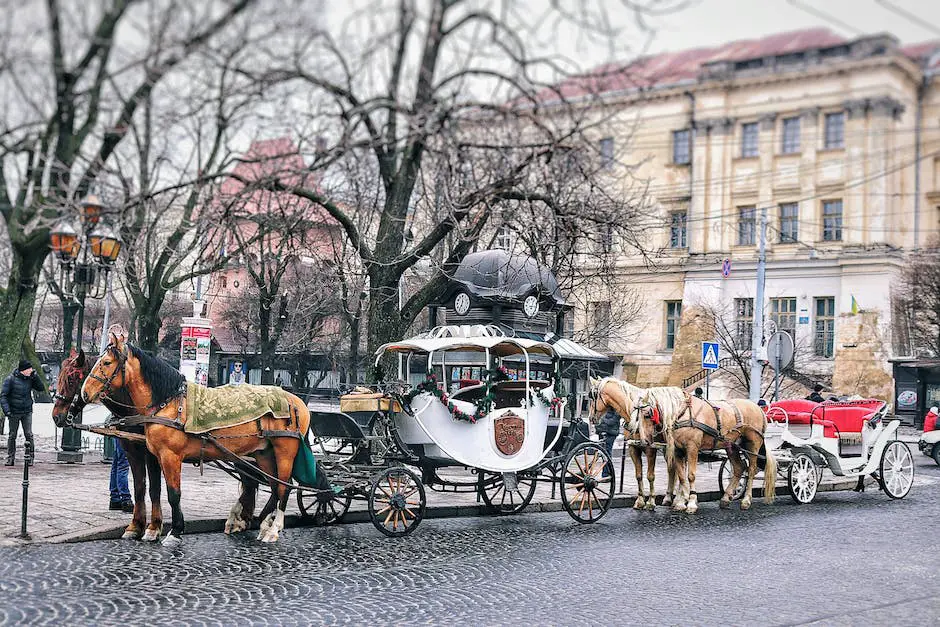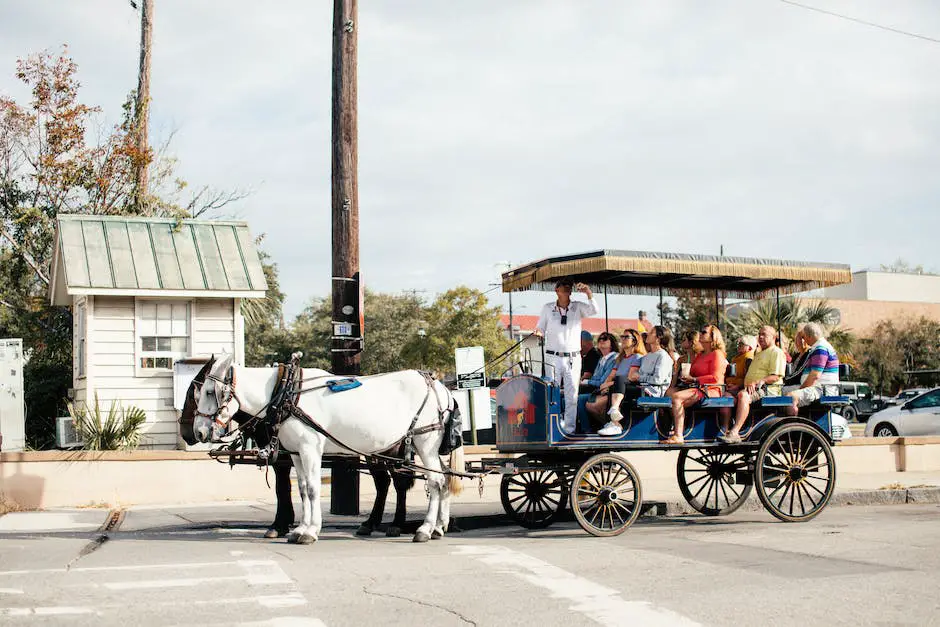Immersed in cultural heritage and function, German Carriage Horses have a significant place in history. They were, and still are, celebrated for their robust stamina and elegance. From early transportation times to contemporary usage, these horses have had a potent influence on societal and economic domains. With varied breeds and distinctive characteristics, these horses were the heartbeat of old-world Germany, integral to trade and transport. Through exploration of historical significance, comprehensive understanding of breeds and traits, knowledge of training and upkeep, to their current relevance, we get to appreciate the distinctive role each German Carriage Horse played, and continues to play, in fascinating intertwines of history and modern times.
Table of Contents (Horspedia)
Historical Import of German Carriage Horses
The Rise of German Carriage Horses
German carriage horses, also fondly termed as ‘coach horses’, played a significant role in the socio-economic life of Germany from the medieval period to the era of Industrialization. They were predominantly seen in the northern regions of Germany. Breeds like Hanoverian, Holsteiner, Mecklenburger, and Oldenburger were specifically trained for conveyance purposes because of their strength, robustness, and endurance.
Prominence and Role in Transportation and Trade
With the advent of the carriage or wagon as a mode of transport during the 16-17th century, the demand for durable and strong carriage horses escalated. The horses were used for pulling trolleys, carriages, stagecoaches, and post coaches, making transportation of goods and people more efficient. German carriage horses were especially prized for their even temperament, hardiness, and speed, making them ideal for long-distance carriage rides.
Trade also benefited greatly from the use of these horses. Goods were transported across German lands and even to neighboring regions, increasing trade relationships. German carriage horses carried goods like wool, cotton, flax, and other raw materials to the cities. They also helped to distribute finished goods from urban industries to rural markets.
Impact on Society and Culture
German carriage horses not only changed the face of transportation but also left a notable imprint on German society and culture. As status symbols, wealthy owners showcased their carriage horses in public, while middle-class citizens hitched their horses to family wagons for Sunday rides.
These horses also influenced the cultural festivities and events prominently. Competitions involving German carriage horses were organized widely, wherein the elegance, strength, and the quality of the horses were evaluated. This became an integral part of local cultural festivities, thereby fostering community ties and regional identity.
Furthermore, the breeding, training, and trading of these horses gave rise to many related occupations, providing a livelihood to many German citizens. This also led to a significant expansion in the sphere of veterinary medicine in Germany.
The Heritage and Conservation of German Carriage Horses
While the advent of the railway and the automobile has significantly reduced the role of German carriage horses as the primary means of transportation, their historical legacy and vital societal contributions remain acknowledged. Modern conservation efforts thrive to honor the legacy and tradition of German carriage horses, demonstrated through equestrian exhibitions showcasing their majesty, beauty, and elegance. Carriage horse-powered tours that are prevalent in German urban centers serve a dual purpose – offering a journey reminiscent of the past within a contemporary city environment.

Traits and Breeds of German Carriage Horses
The Characteristics of German Carriage Horses
German carriage horses boast a reputation for their stamina, resilience, and tranquil disposition, attributes cultivated over centuries through selective breeding. These horses, marked by their muscular build, wide chests, flexed ribs, potent hindquarters, and robust legs, offer an outstanding mix of speed and sturdiness. Their height ranges from 15.2 to 17 hands, and with a solid frame, they weigh between 1100 and 2000 pounds.
Their serene and patient demeanor makes them ideal for navigating crowded city lanes or embarking on extended trips. Inspite of their size and formidable strength, these horses don a gentle personality and a cooperative spirit, making them a favored choice among carriage drivers.
Breeds of German Carriage Horses
There are several breeds of horses that are commonly used as German carriage horses. These include the Hanoverian, Holstein, Rottaler, and the Trakehner.
The Hanoverian, one of the most well-known German horse breeds, is noted for its versatility and endurance. They stand at around 15.3 to 17.2 hands high and come in a variety of colors including bay, black, chestnut, and gray. Hanoverians have a strong back, muscular hindquarters, a powerful stride, and a quiet, steady temperament, making them well-suited to carriage work.
Holstein horses are another popular breed known for their excellent trot. These horses tend to be larger, typically standing at 16 to 17 hands high. Their muscular build and strong legs make them superb carriage horses, while their calm and cooperative temperament ensures they adapt well to working in various environments.
Rottaler horses, once common in Bavaria, are a sturdy breed with a robust build. They have a strong back, chest, and legs, standing around 15.2 to 16.3 hands high. Although less common today, this breed was historically used for pulling carriages and agricultural work.
Lastly, the Trakehner is known for its elegant appearance and agility. Trakehners are a warmblood breed, standing between 15.2 and 17 hands high. They have a lightweight yet sturdy build with a flowing, powerful trot which is ideal for carriage work. Their color range spans black, bay, chestnut, and grey.
Characteristics of German Carriage Horses
When it comes to German breeds utilized for carriage work, particular traits are valued such as strength, endurance, and a calm temperament. The sturdy structure and physical resilience of these horses allow them to transport heavy loads over extended periods and distances. Their generally docile and agreeable natures, along with their notable trainability, make them excellent companions for working in various conditions. Notably, breeds such as the Holstein and Trakehner are known for their distinctive trot which ensures a comfortable ride, making them top choices in the realm of carriage horses.

Training and Care for German Carriage Horses
Training Regime for German Carriage Horses
Training German carriage horses is a procedure that requires a considerable investment of time, patience and a set of specialized skills. Training generally commences when the horses are young, around three-years-old, although maturing horses can also be trained. The process progresses in levels and depending on the individual performance of the horse, might extend from a few months to a year or more.
In the initial stage, the horse is familiarised with the carriage apparatus and gear, helping it to get used to the texture and noise of the equipment. During this phase, trainers employ techniques of desensitization, which involve incrementally exposing the horse to the cart, harness and the sounds associated with carriage driving.
As the horse becomes more accustomed, it’s taught to react to commands like “walk,” “trot,” “canter,” and “halt.” They are also trained to navigate different courses using voice commands, cues from reins, body language and whip signals. Upon reliable response to these instructions, the horse is slowly introduced to pulling lightweight carriages.
Challenges such as the horse being scared by the noise and sensation of the carriage are common. Therefore, trainers must tackle each training session with ample sensitivity and patience.
Caring for German Carriage Horses
Providing the necessary care for German carriage horses involves a specialized routine to maintain their health and ensure they are fit for service. Essential tasks include regular grooming, like brushing their coats, checking and managing their hooves, and keeping their manes and tails tangle-free. This not only preserves their stunning aesthetic but also aids in preventing conditions like skin diseases.
A well-balanced diet, another critical element of their care, fuels these horses for their active duties. They need a combination of grains, hay, fruits, vegetables, and generous supplies of fresh water. Depending on their specific performance needs, some of these horses may require specialized diets.
Another responsibility of the owners and handlers of these horses is to ensure they receive regular health check-ups for early detection of potential problems, which usually include dental checks, vaccinations, and deworming—essential services for maintaining optimal health and performance. Alongside this, these horses need plenty of exercises. Therefore, between their tasks of pulling carriages, it’s necessary to provide sufficient time for free-range movement and play.
German carriage horses also require particular hoof care. Depending on their growth rate, their hooves need to be trimmed every four-to-six weeks. Many carriage horses also need horseshoes due to their extensive work on hard surfaces.
All these efforts in training and care are paramount for these horses to sustain their intensive tasks while ensuring they remain comfortable, safe, and in good health.

German Carriage Horses in the Modern World
Current Role of German Carriage Horses
The esteem for German carriage horses transcends their origin in Germany, earning them an international reputation as one of the most admired breeds. Their aesthetic elegance and adaptable functionality contribute immeasurably to their modern value and role, evident not only in Germany but in various countries across the globe. These versatile horses undertake a multitude of roles – they’re seen pulling carriages for modern tourists, showcasing their skills in equestrian sports competitions, and serving the steady demand for traditional horse-drawn carriages in both rural and urban settings.
The Current Breeding Programs
To preserve the unique traits and ensure the survival of German carriage horses, numerous breeding programs have been instituted across Germany and globally. The breeding programs often emphasize the strength, stamina, and composure that make these horses perfect for carriage pulling. Moreover, they also focus on maintaining or enhancing the horses’ unique, elegant beauty and calm demeanor, which further adds to their appeal. Also, genetic diversity is encouraged to maintain a healthy population of these horses. Selective breeding strategies are employed to ensure the breeds remain pure and that the best traits are carried forward.
Usage in Contemporary Germany and Worldwide
In Germany, these horses still play significant roles in historic celebrations, serving as a living testament to Germany’s cultural heritage. Carriage rides are a popular attraction, especially in historic or scenic townships, offering a unique perspective and a memorable experience for locals and tourists alike.
Internationally, German carriage horses enjoy considerable popularity, with enthusiasts worldwide appreciating their powerful yet elegant stature. For example, in the United States, these horses are commonly seen in Amish communities where traditional modes of transportation are preferred. They are also used for carriage rides in tourist-heavy regions, such as Central Park in New York City.
In Tourism
German Carriage horses have become an emblematic part of tourism globally. They are often seen in town squares or historic sites offering scenic or romantic rides, allowing riders to enjoy a journey reminiscent of bygone eras. Their aesthetic appeal and disciplined nature make them an ideal choice for tourists seeking a unique, enjoyable experience. For example, carriage tours in cities like Vienna and Salzburg are immensely popular among tourists, narrating the story of the city while providing a quaint Yet unique travel experience.
In Competitive Sports
The athleticism and endurance of German carriage horses do not go unnoticed in the field of competitive sports. They often feature prominently in carriage driving competitions, a sport included in the World Equestian Games. These horses display excellent performance in dressage, marathon and cone driving events due to their balanced structure and calm demeanor.
In conclusion, the status of German Carriage Horses in the modern world remains significant, honoring their historic legacy while continually adapting to the changing times. Their importance today transcends cultural boundaries and helps carry forward a rich tradition of horse-driven carriage.

As we have traversed through historical eras and modern times, we have gained a holistic insight into German Carriage Horses’ invaluable contribution. While the days of hectically crowded horse markets and their primordial role as the principal means of transportation are long past, their legacy persists in a myriad of ways. From roles in tourism to competitive sports to continuous breeding programs, these magnificent creatures continue to be a testament to their historical import. The journey through time elucidates their significance, their beauty and strength and makes one appreciate their indomitable presence in the tapestry of global history. This understanding creates a profound respect for these remarkable creatures that have stood the test of time to remain interconnected with our lives in the most enriching ways possible.

